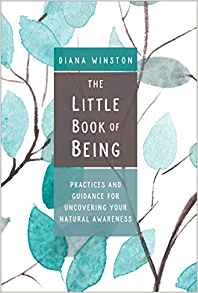 Winston, D. (2019). The Little Book
Winston, D. (2019). The Little Book
of Being: Practices and guidance for uncovering your natural awareness. Boulder, CO: Sounds True. ISBN 978- 1683642176.
Written by Diana Winston
Reviewed by Kathryn Metro
Diana Winston’s new guide, The Little Book of Being, draws on her twenty- nine years of experience to describe the concept of natural awareness through mindfulness. Natural awareness is the ability to perceive, sense, feel, or be cognizant of an experience or situation. The book is geared to anyone who wants to try meditation and to experienced meditators who want to try new methods.
The book includes chapters that instruct people new to meditation on the basics, as well as practices that can augment or invigorate the existing practices of experienced meditators. Winston writes in short, concise chapters and uses simple vocabulary to make the book feel accessible. She also includes “glimpse practices,” which can be included in a daily meditation.
The first part of the book focuses on the foundations of natural awareness, providing a basic overview of what, why and how it works. The second part discusses techniques for both mindfulness and natural awareness meditations, using classic mindfulness as a starting point. In the third part, Winston writes about tools for recognizing existing natural awareness and how living a life of natural awareness can be fulfilling.
Winston describes awareness as a “capacity of the human mind.” It is the ability to perceive, sense, feel, or be conscious of an experience. Natural awareness is an awareness in which the focus is on the state of feeling aware, rather than what we are being aware of. In the first part of her book, Winston lists some markers of natural awareness, noting that it might feel like “your mind is completely aware and undistracted without you doing anything in particular to make yourself aware” (13). The reason Winston refers to this type of awareness as being “natural” is because this is natural or inherent to all humans, because we have all had experiences during which our mind feels at ease. It is also natural because the awareness is perpetually available so long as we can fnd it. Winston points out that meditators likely have already experienced natural awareness and have probably been working too hard to achieve it.
The techniques’ section of the book includes simple guidelines for successfully achieving natural awareness. Winston specifies the best length, time of day, location, and frequency for natural awareness. She also emphasizes the importance of clarifying and setting intentions before beginning to meditate. I’ve found it can be helpful if you set a motivation for meditation and deliberately state what the practice is about. Some people might want to meditate to benefit not just themselves but people around them because
“transforming our own minds impacts our families, work, friends, neighborhoods, communities, and the institutions of which we are apart” (60). Setting motivation might make meditation meaningful when it feels difficult or banal.
The embodiment section of the book provides tips about how to maintain and augment the practice of natural awareness. Winston points out that “the cultivation of natural awareness takes ongoing, regular practice, both formal and informal.” Therefore, in order to master the art of natural awareness, we must integrate deliberate meditation and informal practice. The two methods mutually support each other. Winston advises readers to spend time in nature because of its rejuvenating and peaceful presence. She believes that nature somehow helps us tap into our natural awareness, by taking us back to a preindustrial stage. Even if the closest natural setting is a park, Winston claims that being outside can positively impact our ability to be aware and our quality of life. Another strategy that Winston mentions is “fake it till it’s real.” At times when natural awareness seems unreachable, Winston encourages readers to pretend it is here, repeating the phrase “it’s already here, I’m already aware.” Repeating this phrase can help one to recall that natural awareness exists even when it’s not exactly apparent.
Winston’s new guide offers helpful advice for both novice meditators and experienced meditators looking to improve their practice. The concept of “natural awareness” can seem vague at times, and Winston repeatedly defines it throughout the book. However, her “glimpse” exercises and anecdotes help the guide feel more engaging and the concept of natural awareness to feel more accessible.
Diana Winston is the Director of Mindfulness Education at UCLA Semel Institute’s Mindful Awareness Research Center (MARC) and has taught mindfulness since 1999 in a variety of settings. She is a founding member of the International Mindfulness Teachers Association. She is one of the early founders of meditation programs for youth and is currently focusing on mindfully parenting her daughter.
 Kathryn Metro studies applied psychology at New York University and is set to graduate in 2021. She has worked in various classrooms around the Greater New York City area, and is interested in writing, communications and Spanish.
Kathryn Metro studies applied psychology at New York University and is set to graduate in 2021. She has worked in various classrooms around the Greater New York City area, and is interested in writing, communications and Spanish.






